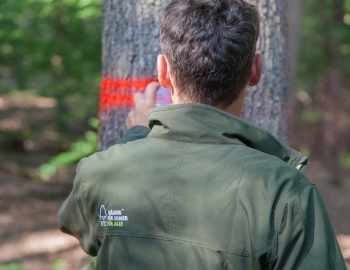
FSC has joined 100+ NGOs supporting the #Together4Forests movement.


We do this by convening our members and other partners from diverse interests to set global benchmarks for forest stewardship that deliver significant results for the forests and the people that depend on them. How we do this is outlined in the FSC Global Strategy 2021–2026.
Our work is governed by the FSC Statutes; documents that set the foundation on which FSC is built. They are updated every three years, through motions proposed by FSC members at the organization’s General Assembly.
As the world changes, so do the demands on forests. From climate change to increased market needs and local conflicts, our approach to the stewardship of the world’s forests must adapt to take these new challenges and opportunities into account. The FSC Global Strategy defines these adaptations. It is developed by the FSC membership, under the leadership of our International Board of Directors, to set the direction of the organization for five years at a time.
The FSC Global Strategy 2021–2026 reaches back into FSC’s roots and emphasizes the role of forest stewardship as the way to enable resilient forests. Without resilient forests, we will lose the fight against climate change and against the alarming loss of biodiversity.
Rather than develop a prescribed list of actions, the strategy enables the collaborative co-creation of solutions that respond to emerging challenges and opportunities.
Through 3 strategies and 12 goals, FSC aims to grow its reach within the next years, so that by 2026 the value and benefits of forest stewardship are demonstrated in 300 million hectares of FSC-certified area, of which 50 million hectares are natural tropical forests and areas managed by smallholders.
 Dense forest with pinecones littering ground
Dense forest with pinecones littering ground
We will drive forest stewardship by making certification attractive, usable, and viable for potential users. We will protect our credibility and demonstrate impact through modern technology, and together with our members and partners, we will co-create solutions to forest-related challenges.
 Pile of logs with FSC stamp
Pile of logs with FSC stamp
We will foster market uptake of FSC to drive outcomes on the ground and greater value to certificate holders, supporting the shift to biobased and low-carbon circular economies. Through improved data and powerful communications, we will highlight the social, environmental, and economic value and benefits of FSC-certified forests and their products and services. We will work with market actors to enhance and satisfy demand for certified products and services, focusing on sectors with greatest opportunity for impact to achieve the 2050 vision.
 Man with FSC jacket spray painting tree
Man with FSC jacket spray painting tree
Following up on increased efforts in the past few years, we will work with diverse organizations and stakeholders to increase the recognition of the value and benefits of forests and FSC’s role as the most credible validation of forest stewardship. We will expand and invigorate our partnerships and alliances as efficient ways to contribute to global agendas and boost results on the ground. We will deliver on our mission, create results that matter to our members and partners, and seek opportunities in the broader landscape where we can achieve results without increasing the burden on the FSC system and our certificate holders.

FSC is the pioneer of a multi-stakeholder governance system that gives equal weight to economic, environmental, and social chambers – an approach respected by many NGOs as the gold standard. FSC is also the only forest certification system with an integrated accreditation programme that systematically verifies its certification bodies. For these reasons, FSC is widely regarded as the most credible and effective forest certification system.
Learn more about how the FSC system works here.

The FSC General Assembly is FSC’s premier decision-making body. Here members representing environmental, social, and economic interests, come together every three years to set the organization’s direction.
FSC members discuss and vote on motions that may fundamentally affect the way FSC is run.
To ensure that all voices are heard equally, each FSC chamber holds 33.3 per cent of the vote on all FSC matters. Within each chamber, votes are weighted to ensure that North and South each hold 50 per cent of the vote.

The FSC Board of Directors is accountable to all members. It consists of 12 elected representatives, with four elected from each of the chambers for a four-year term.

The FSC Policy and Standards Committee acts on behalf of the Board of Directors (BoD) with respect to technical matters related to the development or revision of FSC Policies, Standards, Procedures and other normative documents. The FSC Policy and Standards Committee takes final decisions on FSC requirements based on regular processes and Forest Stewardship Standards upon conducting technical and procedural reviews. The PSC also provides technical reviews and recommendations for approval of FSC requirements following major processes based on FSC’s standard setting procedure.

FSC is committed to working with Indigenous Peoples by upholding their ownership, use, and management rights across their landscapes.